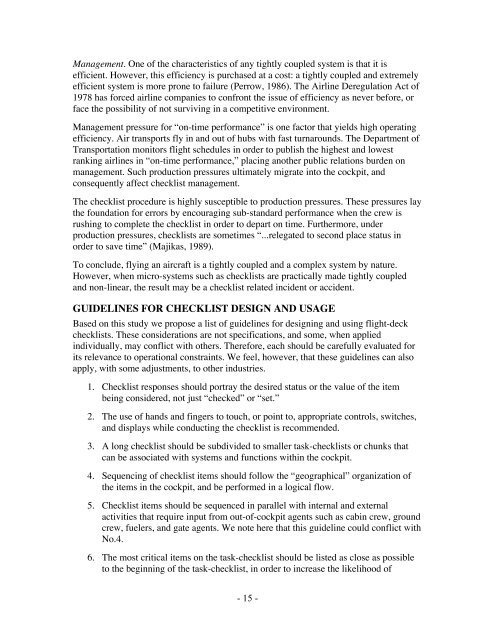COCKPIT CHECKLISTS: CONCEPTS, DESIGN, AND USE - NASA
COCKPIT CHECKLISTS: CONCEPTS, DESIGN, AND USE - NASA
COCKPIT CHECKLISTS: CONCEPTS, DESIGN, AND USE - NASA
Create successful ePaper yourself
Turn your PDF publications into a flip-book with our unique Google optimized e-Paper software.
Management. One of the characteristics of any tightly coupled system is that it isefficient. However, this efficiency is purchased at a cost: a tightly coupled and extremelyefficient system is more prone to failure (Perrow, 1986). The Airline Deregulation Act of1978 has forced airline companies to confront the issue of efficiency as never before, orface the possibility of not surviving in a competitive environment.Management pressure for “on-time performance” is one factor that yields high operatingefficiency. Air transports fly in and out of hubs with fast turnarounds. The Department ofTransportation monitors flight schedules in order to publish the highest and lowestranking airlines in “on-time performance,” placing another public relations burden onmanagement. Such production pressures ultimately migrate into the cockpit, andconsequently affect checklist management.The checklist procedure is highly susceptible to production pressures. These pressures laythe foundation for errors by encouraging sub-standard performance when the crew isrushing to complete the checklist in order to depart on time. Furthermore, underproduction pressures, checklists are sometimes “...relegated to second place status inorder to save time” (Majikas, 1989).To conclude, flying an aircraft is a tightly coupled and a complex system by nature.However, when micro-systems such as checklists are practically made tightly coupledand non-linear, the result may be a checklist related incident or accident.GUIDELINES FOR CHECKLIST <strong>DESIGN</strong> <strong>AND</strong> USAGEBased on this study we propose a list of guidelines for designing and using flight-deckchecklists. These considerations are not specifications, and some, when appliedindividually, may conflict with others. Therefore, each should be carefully evaluated forits relevance to operational constraints. We feel, however, that these guidelines can alsoapply, with some adjustments, to other industries.1. Checklist responses should portray the desired status or the value of the itembeing considered, not just “checked” or “set.”2. The use of hands and fingers to touch, or point to, appropriate controls, switches,and displays while conducting the checklist is recommended.3. A long checklist should be subdivided to smaller task-checklists or chunks thatcan be associated with systems and functions within the cockpit.4. Sequencing of checklist items should follow the “geographical” organization ofthe items in the cockpit, and be performed in a logical flow.5. Checklist items should be sequenced in parallel with internal and externalactivities that require input from out-of-cockpit agents such as cabin crew, groundcrew, fuelers, and gate agents. We note here that this guideline could conflict withNo.4.6. The most critical items on the task-checklist should be listed as close as possibleto the beginning of the task-checklist, in order to increase the likelihood of- 15 -
















